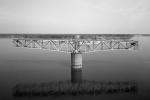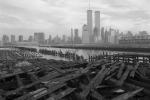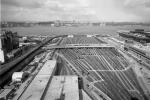Historic Engineering
Historic Engineering Photography provides a visual documentation of processes and the way things work such as bridges, factories, mines, etc.
Featured Projects (click images for larger view):

|
|
The George P. Coleman Memorial Bridge, spanning the York River between Gloucester Point and York, Virginia, is one of the largest and last steel deck-truss double swing span bridges in the world. It was built in 1950 to 1952 during the post-World War II transportation improvements era, but was earmarked for major modification in the early 1990s due to severely increased traffic in the area. It was documented prior to the addition to its entire length of cantilevered lanes on either side. The swing spans were lifted off with cranes and expanded and dropped back into place. Documentation required intensive photography of the bridge from many surrounding vantage points, inside caissons, under the deck, in traffic lanes, and from many other points in, on, and under the bridge in order to illustrate its operation and details.
|

|
|
The Delaware, Lackawanna, and Western Railroad Pier No. 6: Coal and Grain Trestle was an element in the ca. 1900 freight yard of a major coal handling railroad in Jersey City, New Jersey in the New York/New Jersey harbor. It was considered significant because it was the last vestige of the rail yard and was the only inclined and elevated coal pier in the harbor in the first quarter of the 20th Century. It's structure, construction details, and extant operational hardware were photographed so that it could be demolished to make way for Jersey City's development of its harbor area. The photos illustrate the stark contrast between the gritty, industrial past of this harbor and the upscale commercial hub it has become.
|

|
|
When the New Jersey Jets decided to lobby for the right to build a stadium on Manhattan Island in New York City, New York, it was apparent that space in the city is at such a premium that construction could only be contemplated within the air rights over another space already in use. The idea was floated to build a platform over the Long Island Railroad 30th Street Rail Line on Manhattan's West Side in midtown, on which a stadium could then be constructed. This would, however, severely impact the historic High Line, which rings the rail yard after exiting a tunnel from Long Island in its northeast corner and climbing to a height that would allow trains to travel above street grade all the way downtown. A Historic American Engineering Record documentation project was commissioned to mitigate the visual effects to the elevated rail structure. The stadium project has since been scrapped due to political and citizen opposition, but the elevated track structure has been taken over by the city and is slated to become a New York City Greenway.
|
|